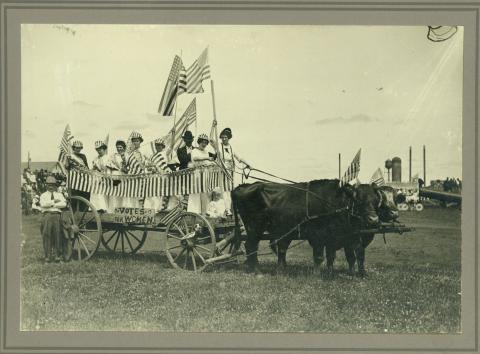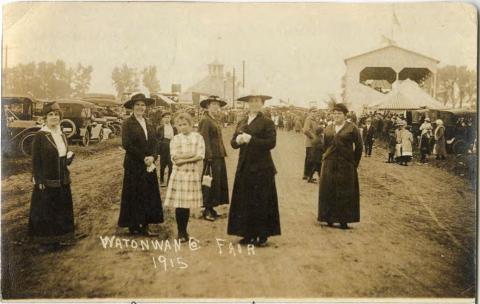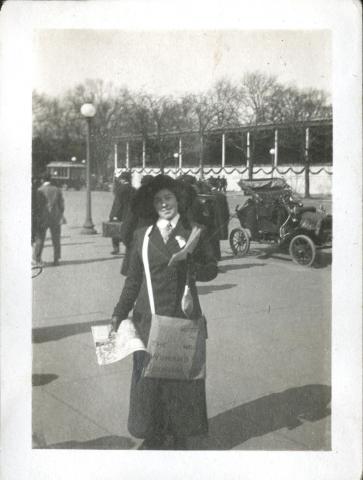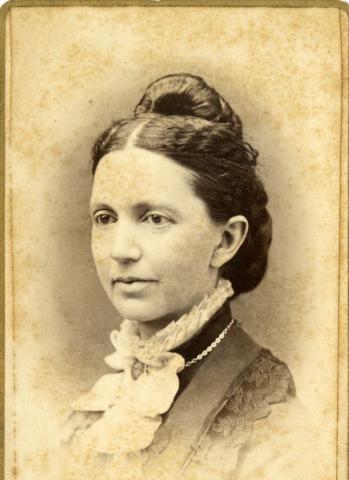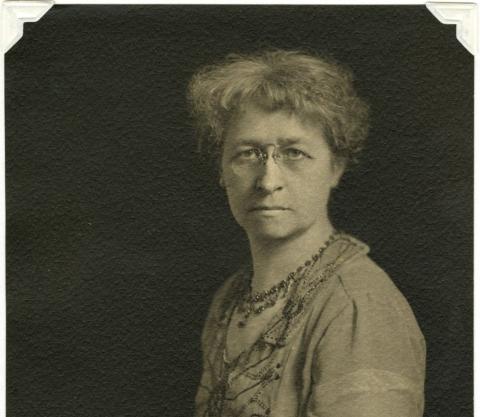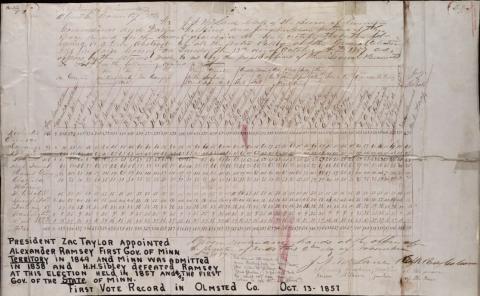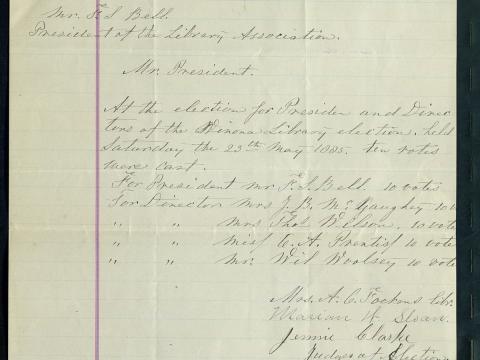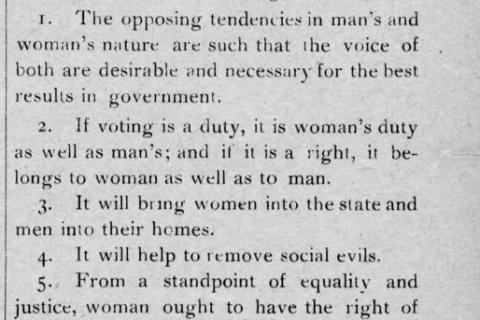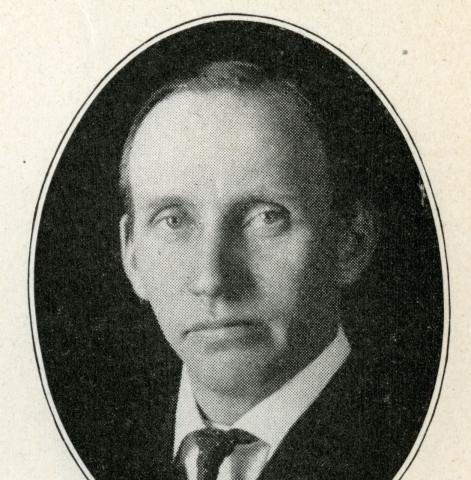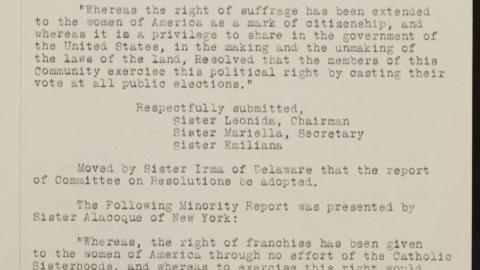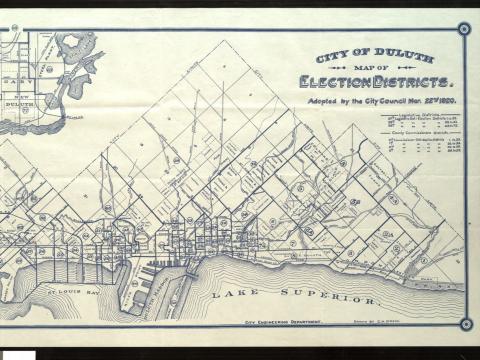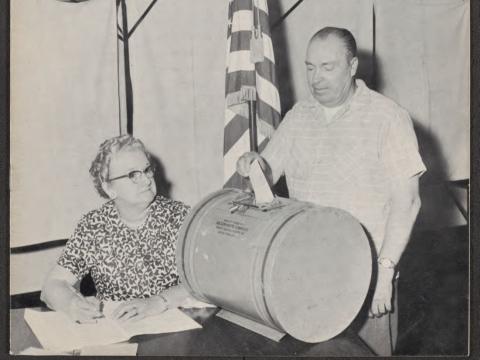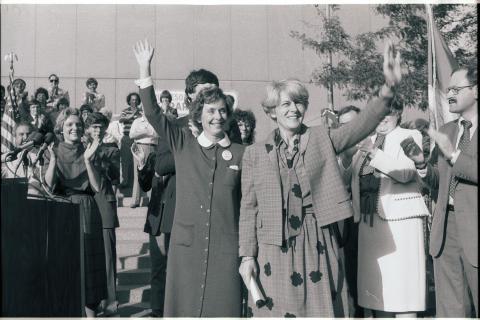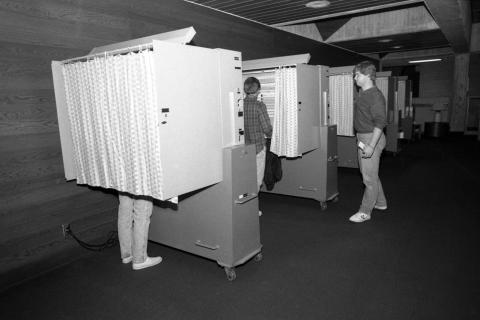Primary Source Set
by Stephanie Hess, Digital Curator, Minnesota Digital Library
People of Minnesota Politics and Government Social Issues
Women in America began advocating for suffrage, or the right to vote, before Minnesota even became a state. In 1848, over 300 people gathered in Seneca Falls, New York, to discuss women’s rights. Together, they wrote and signed the Declaration of Sentiments and Grievances, which included twelve principles that would guide the work of the women’s suffrage movement for years to come.
The suffrage movement was not monolithic. Some suffragists allied themselves with abolitionists and temperance advocates (those trying to control or abolish alcohol use), which earned the movement supporters as well as enemies. Women of color were sometimes excluded from national women’s suffrage organizations like the National American Woman Suffrage Association, so they created their own advocacy groups.
In the 1870s, Minnesota women began forming local suffrage groups and working for change. The state legislature granted women the right to vote in school board elections in 1875, but not in general elections. In 1881, fourteen women formed a statewide group called the Minnesota Woman Suffrage Association (MWSA), which had over 200 members by 1882. The MWSA tried convincing state legislators to support women’s suffrage with an amendment to the state constitution and nearly succeeded in 1893.
The suffrage movement gained momentum in the 20th century. The MWSA was joined by a local branch of the National Women’s Party, a more radical group of the women’s movement that used direct action to make change. In 1914, over two thousand suffrage supporters marched in Minneapolis in a suffrage parade, and by 1919 thirty thousand women belonged to various suffrage organizations throughout the state. Nationally, President Woodrow Wilson changed his stance against suffrage and began to support the idea of an amendment that would finally grant women the right to vote.
By June 1919, the United States Senate and House of Representatives had both passed resolutions to amend the Constitution to grant women full suffrage. Before the amendment became law, it had to be ratified (or approved) by at least 36 states. In Minnesota, the state legislature met on September 8, 1919 in a special session and approved the federal suffrage amendment. Tennessee became the 36th state to ratify on August 18, 1920 and the Nineteenth Amendment was officially added to the United States Constitution on August 26, 1920.
Discussion Questions & Activities
- Why do you think women were not allowed to vote in general elections until 1920? What evidence can you find to support your thinking?
- The first recorded vote in Olmsted County took place in 1857, and over 1,200 eligible males voted on the new state’s constitution and leadership, including the Governor, Chief Justice, U.S. Congressmen, and more. Compare that voting record to the results from the 1885 Winona Library Association Board of Directors election, in which women could vote as well as be elected. What are the differences in these roles, and why was it acceptable for women to vote for some types of leadership and not others?
- Sarah Burger Stearns was one of the founders of the Minnesota Woman Suffrage Association. How was she similar to national leaders like Susan B. Anthony, Elizabeth Cady Stanton, Ida B. Wells, or Mary Church Terrell? How was she different?
- Read the suffrage debate held by members of a Literary Society (club) at St. Cloud’s State Normal School in 1895. What were the arguments supporting suffrage, and what did the opponents argue? Which arguments are stronger than others? Do any of them surprise you?
- Why did the suffrage movement gain momentum and support in the 20th century? What other social movements were happening at the time? What else was going on worldwide?
- Examine the city of Duluth’s map of election districts from 1920, the first year women could vote. How do you think their participation affected politics locally that year as well as in the state and country?
- Sen. Ole Sageng was a state senator from Otter Tail County who supported prohibition and women’s suffrage. He authored a bill to give women the right to vote and was once called the “Napoleon of Woman Suffrage.” Why did he support the cause? What might he have gotten out of it? What does it mean to be an ally for a cause that does not directly affect your own rights?
- Even after the Nineteenth Amendment was ratified and women could vote, many still chose not to (see the Benedictine Sisters’ debate from 1921 for an example). What is the difference between not doing something because you have a choice and not doing something because it’s against the law?
- How did women’s suffrage lead to women getting involved in politics? Consider Rep. Myrtle A. Cain, one of the first four women to be elected to the state legislature in 1923, as well as Minnesota’s Secretary of State Joan Growe and the Vice Presidential candidate Geraldine Ferraro from 1984, in your answer.
- Compare the voting photo from 1962 with the voting booths in 1988, and find a more recent voting photo online. What do these three voting setups have in common? How are they different? Why did they change? Which one would you rather use?
- Although the Nineteenth Amendment technically granted all women the right to vote, many women of color were still unable to vote after 1920 due to discriminatory laws and customs. How does this affect your understanding of the work for equal rights in America?
- Suffragists had to fight for many years to get what they wanted. What causes would you be willing to fight for, even if it takes a long time and there might be terrible consequences?
eLibrary Minnesota Resources (for Minnesota residents)
Jensen, Cory. "Suffrage." American Governance, edited by Stephen Schechter, et al., vol. 5, Macmillan Reference USA, 2016, pp. 149-150. Gale In Context: High School (accessed March 7, 2024).
Mezey, Susan Gluck. "Nineteenth Amendment." American Governance, edited by Stephen Schechter, et al., vol. 3, Macmillan Reference USA, 2016, pp. 346-349. Gale In Context: High School (accessed March 7, 2024).
"Nineteenth Amendment." Britannica School, Encyclopædia Britannica, 15 May 2020 (accessed March 7, 2024).
"Women’s suffrage (Middle School)." Britannica School, Encyclopædia Britannica, 20 Feb. 2024 (accessed March 7, 2024).
"Women’s suffrage (High School)." Britannica School, Encyclopædia Britannica, 8 Sep. 2023. (accessed March 7, 2024).
"Women's Suffrage." Gale Encyclopedia of U.S. History: War, Gale, 2009. Gale In Context: High School (accessed March 7, 2024).
"Women’s Suffrage Movement." Gale In Context Online Collection, Gale, 2024. Gale In Context: High School (accessed March 7, 2024).
Additional Resources for Research
Cameron, Linda A. "American Woman Suffrage Association Convention, Minneapolis, 1885." MNopedia, Minnesota Historical Society (accessed March 7, 2024).
Cameron, Linda A. "Ratification of the Nineteenth Amendment in Minnesota." MNopedia, Minnesota Historical Society (accessed March 7, 2024).
Dyson, Hannah. "Stearns, Sarah Burger (1836–1904)." MNopedia, Minnesota Historical Society (accessed March 7, 2024).
Gilman, Rhoda. "Women in Minnesota: Weaving the Web of Society in the North Star State." MNopedia, Minnesota Historical Society (accessed March 7, 2024).
Hilfrank, Elizabeth. "The Women's Suffrage Movement." National Geographic Kids (accessed March 11, 2024).
Johnson, Frederick. "Nelson, Julia Bullard (1842–1914)." MNopedia, Minnesota Historical Society (accessed March 7, 2024).
Loetscher, Elizabeth. "Cain, Myrtle Agnes (1894–1980) ." MNopedia, Minnesota Historical Society (accessed March 7, 2024).
Loetscher, Elizabeth. "National Woman’s Party in Minnesota." MNopedia, Minnesota Historical Society (accessed March 7, 2024).
Loetscher, Elizabeth. "Scandinavian Woman Suffrage Association." MNopedia, Minnesota Historical Society (accessed March 7, 2024).
Loetscher, Elizabeth. "Ueland, Clara (1860–1927)." MNopedia, Minnesota Historical Society (accessed March 7, 2024).
Weber, Eric. "Minnesota Woman Suffrage Association." MNopedia, Minnesota Historical Society (accessed March 7, 2024).
"Women's Suffrage." Library of Congress Primary Source Set (accessed March 11, 2024).
Published onLast Updated on
